Jim Wright's Hughes H-1 Racer Update
The latest happy news to arrive was the recent invitation for the H-1 to race the 3 kilometer FAI closed course at Reno on September 13. Because the crew felt that mid-August was a safe completion time, it is planning for the September engagement.
35,000 Hours & Counting
An update on Jim Wright's Hughes H-1 race
from Sport Aviation, August 2002by Kent White
EIGHTEEN MONTHS AGO WE covered the initial efforts of Jim Wright and his crew to build an exact replica of the Hughes racer, the H-1. In that article we learned that the Hughes' crew supposedly spent 42,000 hours building the airplane, from drawing board to first flight. Several months after that article appeared John Newbury called to say that he was one of the original eight engineers Hughes hired for the project in 1934, and that he would be glad to visit Cottage Grove, Oregon, to see the replica's progress.
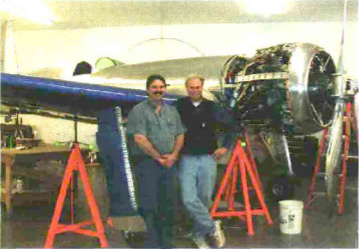 Ron Englund, left, project manager for the H-1,
Ron Englund, left, project manager for the H-1, and the author in a recent photo of the Hughes racer
During his visit Newbury said the replica's impressive workmanship was equal or better than the original, and he concurred with Jim that Hughes' published time investment was, most likely, conservative. When we add up the time for Jim's detailed analysis of the original airplane at the Smithsonian National Air and Space Museum, the subsequent creation of 1,500 engineering drawings used to produce parts, and the labor to construct the airplane thus far, the total time is now in excess of 35,000 hours, making Hughes' figures somewhat "astonishing."
Another "controversy" was the capacity of the H-I's oil tank. Press reports gave it as 35 gallons, but the tank's accurate duplicate holds a measured 16 gallons, which is also confirmed by a recently found Hughes' document.
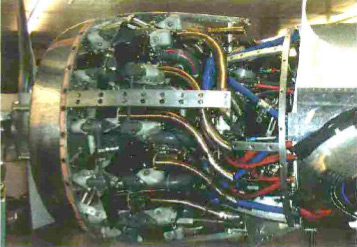 A side view of the R-1435 showing the very tight clearance between the engine and the cowling, and the unusual "thrusting" exhausts
A side view of the R-1435 showing the very tight clearance between the engine and the cowling, and the unusual "thrusting" exhausts
In the past 18 months Jim Wright's crew has been productively engaged in finishing the fuselage, doing the final paint on the wing and then joining it to the fuselage, building the complete tail fin and horizontal stabilizer assembly, and building and installing the tail wheel assembly. They also received the completely overhauled and pre-run Pratt & Whitney engine from Tulsa Aero Engines and installed it. The instrument panel is assembled, and all of the gauges check out. The tail cone is finished, and the seat and the canopy are nearly finished. Except for the sheet aluminum "grass cutters" on the gear legs, every exterior part of the airplane is done and fit. Whew! Busy crew.
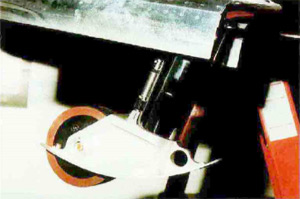
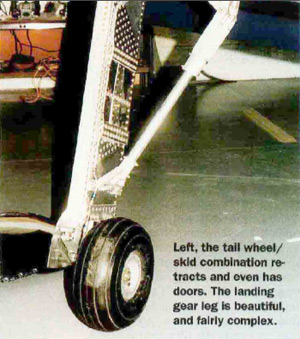
During painting it was found that the wing's upper surface had dried well through the primer-surfacer process, and the paint applied well and dried nicely. The lower surface, however, was done later in the year, and the wet weather inhibited the solvents from volatizing efficiently. As a result, some of the solvents went down and in rather than up and out. The wing's plywood covering responded by absorbing some of the entrapped solvents and noticeably moving around a bit. Gradually, with the painting crew's astute attention, the surface finally dried enough to stabilize, and one more thorough sanding leveled the last coat. The last paint went on without a hitch, and the whole wing looks stunning.
The tail section was fairly straightforward, if you discount the inherent weakness in the original design that allowed some unnecessary crumpling when Howard landed in the beet field. Jim and his crew felt that adding some strength to that area was in order, so they moved and modified a few stiffeners to increase the overall strength of the tail.
On the original a mechanically retracted skid on an air spring kept the tail off the ground. Jim chose a combination skid and wheel unit for better tracking on pavement and a Beech oleo strut to replace the air spring. The Jim Wright-unit still hand cranks up and down like the original, but the crank is not quite finished yet. During the airplane's first engine run and low-speed taxi tests in March, the oleo strut needed only a slight amount of re-pressurizing to bring it back up after sitting static for a couple of months. Good seal!
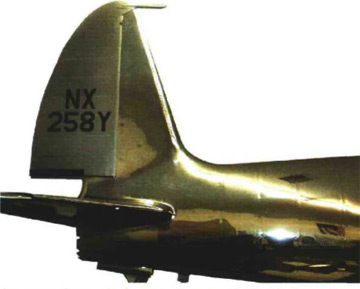 The tail of the H-l is beautiful;
The tail of the H-l is beautiful;some say better than the original
Making the large pair of skins on the tail was a bit tricky for me. Their shapes went from a simple curve around the fuselage at the front edge to heavy reverses in the center at the base of the tail fin, and then they went absolutely flat the rest of the way up the fin. It took a couple of attempts to get the correct amount of shape to happen in the right places, but the left and right sides (0.032-inch T-6 aluminum) finally nailed down tight and polished very nicely. Because the tail fin angles to the left on the fuselage, each of the two skins has its own distinct shape! The horizontal stabilizer, rudder, and all of the controls are finished, though the trim cranks need final installation.
The landing gear has been thoroughly checked and fitted to eliminate any tightness or interferenceâ which was no small task because of the complexity of the hinge-point geometry and the tightness of the fits when the legs go into the wing. Using pneumatic pressure the crew has cycled the legs many times and is ready now to employ a hydraulic "mule." This device runs in parallel with the engine pump without actually using it and will allow the men to further cycle the gear a couple of hundred times, ensuring complete confidence in the system. No deadlines here, only the satisfying joy in the process of building a beautiful airplane to the best of one's ability. (Despite all of his money and success even Howard could not say he was happy, which he admitted to a reporter at the end of his life.)
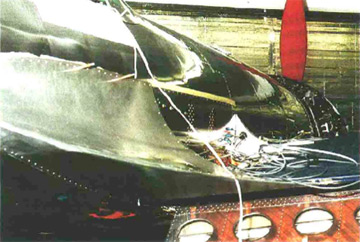 The wing root fairings conceal a large assortment of plumbing and electrical lines. Very little space goes unused on this airplane.
The wing root fairings conceal a large assortment of plumbing and electrical lines. Very little space goes unused on this airplane.
On the taxi test the brakes worked a bit too sensitively, so the current thought is to change the linkage ratio first, then to decrease the mechanical advantage by increasing the piston diameters if the linkage doesn't respond.
Jim's crew checked the fuel flow by disconnecting the fuel line from the carburetor, running the fuel into a bucket and timing for rate of delivery. It was only three-quarters of what is specified for the Pratt & Whitney R-1435, so they pulled and checked the transducer and then had to reprogram its K-factor from 29,000 pulses per gallon to 21,000. Fuel quantity is not yet calibrated to the sight gauges, but it will be done within the month.
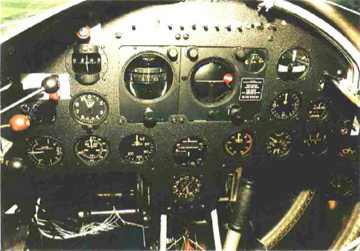 The "original" panel is complete and ready.
The "original" panel is complete and ready.With the instrument panel now fully assembled, all of the pressure and temperature gauges are finished and connected, except for cylinder head and exhaust temperature indicators. These require sensors made especially for the R-1435, and they in turn need attached connecters built and accurately calibrated for their length. With enough of the airplane presently finished, these odd parts can now be made and assembled to the gauges by Keystone Precision Instruments in Whitehall, Pennsylvania.
The original three-axis autopilot "head" looks at you from the panel, but it's hiding a "Jim Younkin" digital brain instead of the original's heavy hydraulic pump and piston assemblies. This saved 16 pounds, about half of the weight savings realized on the project. The original is documented at 4,097 pounds and the replica weighs 4,060 pounds, the miniscule difference offering testimony to patient accuracy.
The replica seat was found by sending photos of the original to an aviation boneyard. The one that arrived was marked as U.S. manufacture but had British Whitworth fasteners, suggesting that even seat manufacture went global. The original H-l seat had a complex architecture that enabled it to adjust fore and aft, up and down, and tilt, lifting Howard's viewpoint above the canopy line. Because this was a bit much to ask his crew to replicate, Jim is foregoing the tilt, but keeping up-down and fore-aft capabilities, and he needs only to get a little more positive latching into the mechanism to be satisfied. Belts will be next when the seat is finished, after which the sliding window in the canopy gets attention.
The latest happy news to arrive was the recent invitation for the H1 to race the 3 kilometer FAI closed course at Reno on September 13, the same Friday 67 years after Hughes claimed the Unlimited record for the airplane. Because the record class has changed, the replica will need only break 266 mph to beat the record for a single-engine propeller-driven aircraft in that weight bracket.
Because the crew felt that midAugust was a safe completion time, it is planning for the September engagement. The FAA requires 50 hours of flight time before leaving the home area, and at 10 hours per week, the September date appears to be safe enough. After that, Universal Studios has offered the opportunity for the H-l to appear in a film on Howard Hughes.
Both flight characteristics and the full amount of prop pitch are awaiting discovery, but such are the mysteries that sustain these guys. Jim Wright says that of all the surprises found so far, he is most surprised at the exceptionally high level of interest in both the H-l and in Howard Hughes.



